The ancient theatre of Epidaurus is a popular day trip from Athens. Here is some information about this spectacular UNESCO site.
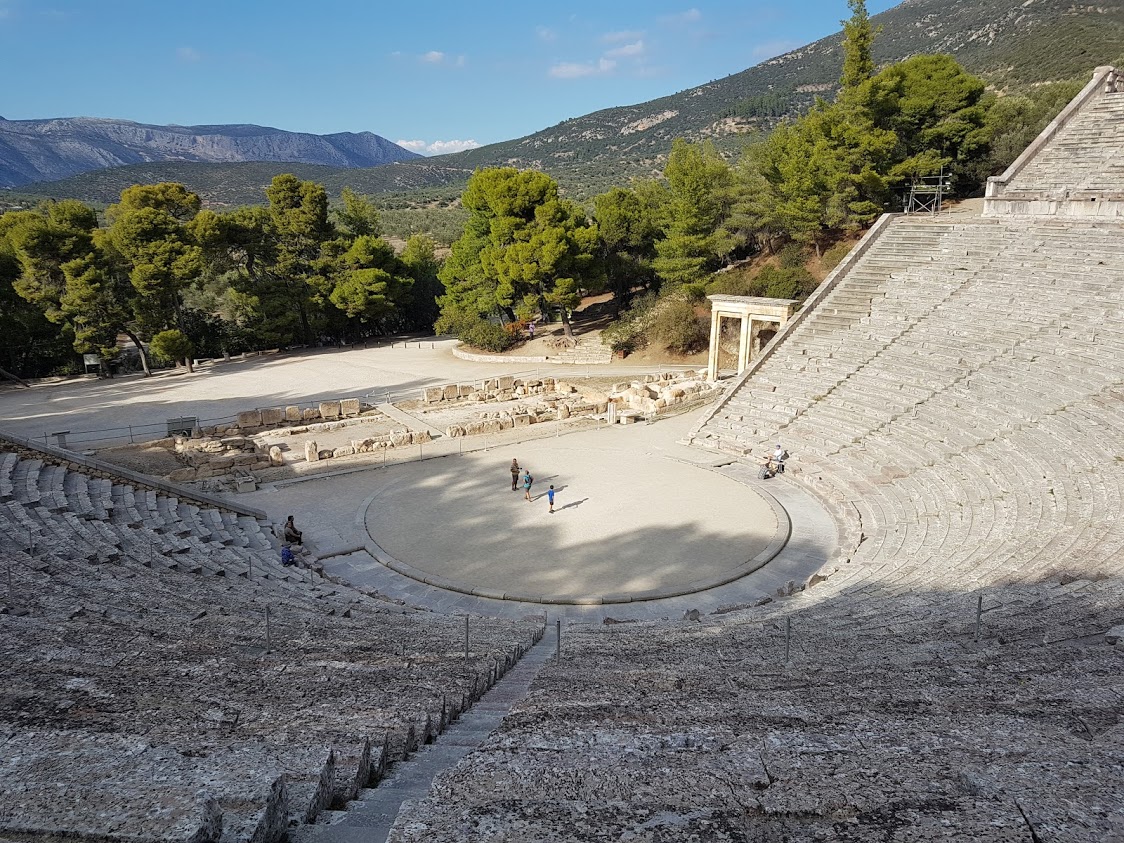
Epidaurus ancient theatre and site
The archaeological site in Epidaurus is one of the most significant ancient sites in Greece. Its official name is Sanctuary of Asklepios at Epidaurus, or Asklepieion of Epidaurus.
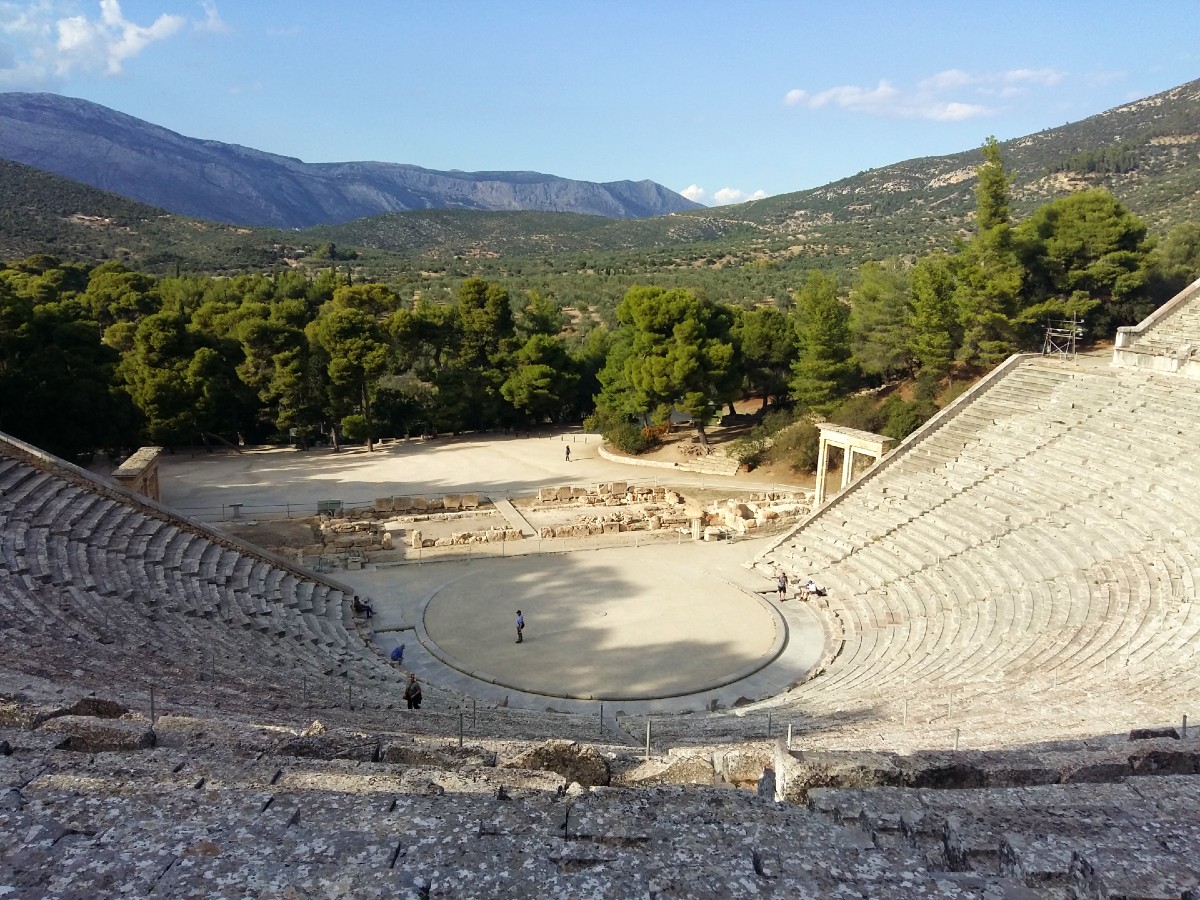
For most people, the highlight of their visit is the Ancient theatre of Epidaurus. Known for its superb acoustics, this magnificent theatre is still used for performances and ancient drama.
Epidaurus is in the region of Argolis in the Peloponnese, a comfortable 2-hour drive from Athens. Other nearby attractions include Ancient Mycenae and the city of Nafplion. Ancient Olympia is 3 hours away by car.
Let’s have a look into the site’s history, and why it was so important.
The importance of Epidaurus in Ancient Greece
Most visitors know Epidaurus for its ancient theatre with the world-famous acoustics. Not everyone realizes that the site was a lot more than this.
The ancient theatre is located inside the grounds of the sanctuary of Asklepios / Asclepius, the ancient god of medicine and healing. It was built to host musical and theatrical shows in his honour.
But what’s the connection between a theatre and the god of medicine? To answer this question, we need to go back in time.
The sanctuary of Asklepios
Towards the beginning of the 4th century BC, a sanctuary of Asclepius was established in the area of Argolis. The sanctuary developed into the most important healing center in ancient Greece.
A grand limestone temple dedicated to the god was built around 380 – 370 BC. A gold-and-ivory chryselephantine statue of Asklepios was placed inside. The impressive monument was destroyed in the 5th century AD, and only a few ruins are visible today.
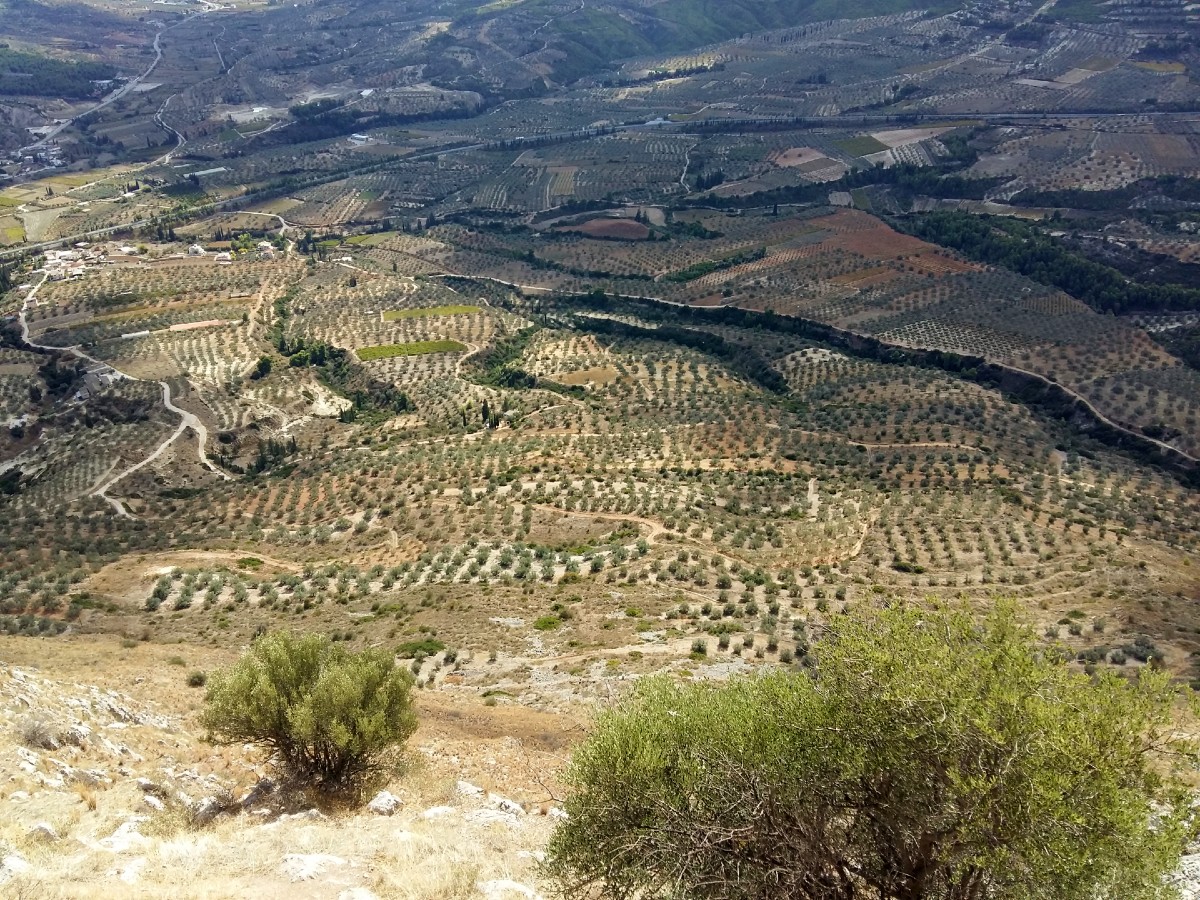
However, Asklepios wasn’t the first healing god worshipped in this area. His cult followed that of his father, Apollo Maleatas, who was known to cure the diseased since around 1,000 BC.
In turn, Apollo Maleatas had replaced and earlier deity who was worshipped during the Mycenean era. This is undoubtedly related to the presence of therapeutic springs in the area.
The important healing centre of Epidaurus
Over the years, the therapeutic powers of Asklepios became more and more famous. The ancient complex became the equivalent of a modern hospital / wellness centre. Patients and pilgrims travelled from far and wide to be treated.
It’s worth noting that there were many more sanctuaries of Asklepios in different areas of Greece, operating in a similar fashion. In some regions, it was even believed that Asclepius could bring people back from the Underworld.
Still, the sanctuary in Epidaurus became the most important therapeutic establishment in Ancient Greece. New monuments and buildings were constructed, to accommodate the growing numbers of visitors.
The Ancient Theatre of Epidaurus
So how about the ancient theatre of Epidaurus? What is its connection with the ancient god?
According to the famous ancient Greek geographer Pausanias, the theatre of Epidaurus was built in 340 – 330 BC, at the time when the ancient sanctuary was very popular.

The theatre was built to provide a space for musical competitions and performances, which would be held to honour the popular god.
Interestingly, the ancient Greeks believed that artistic performances could improve people’s physical and psychological health. Perhaps drama and art therapy aren’t as new as we thought!
What does the Epidaurus ancient theatre look like?
The Epidaurus theatre is one of the best preserved theatres in Greece. The main materials used for its construction were limestone and poros stone.
Originally, its capacity was around 8,000 people, but it increased in the 2nd century BC. It is estimated that it could fit audiences of 13,000-14,000 people.
Unlike many other Greek theatres, for example the one in Milos, it wasn’t modified during the Roman era.
The theatre seats were divided into a lower and an upper tier. In order for the audience to move around, several corridors separated the rows of seats into smaller sections.
The orchestra, the circular stage where the performers appeared, had a diameter of 20 metres.
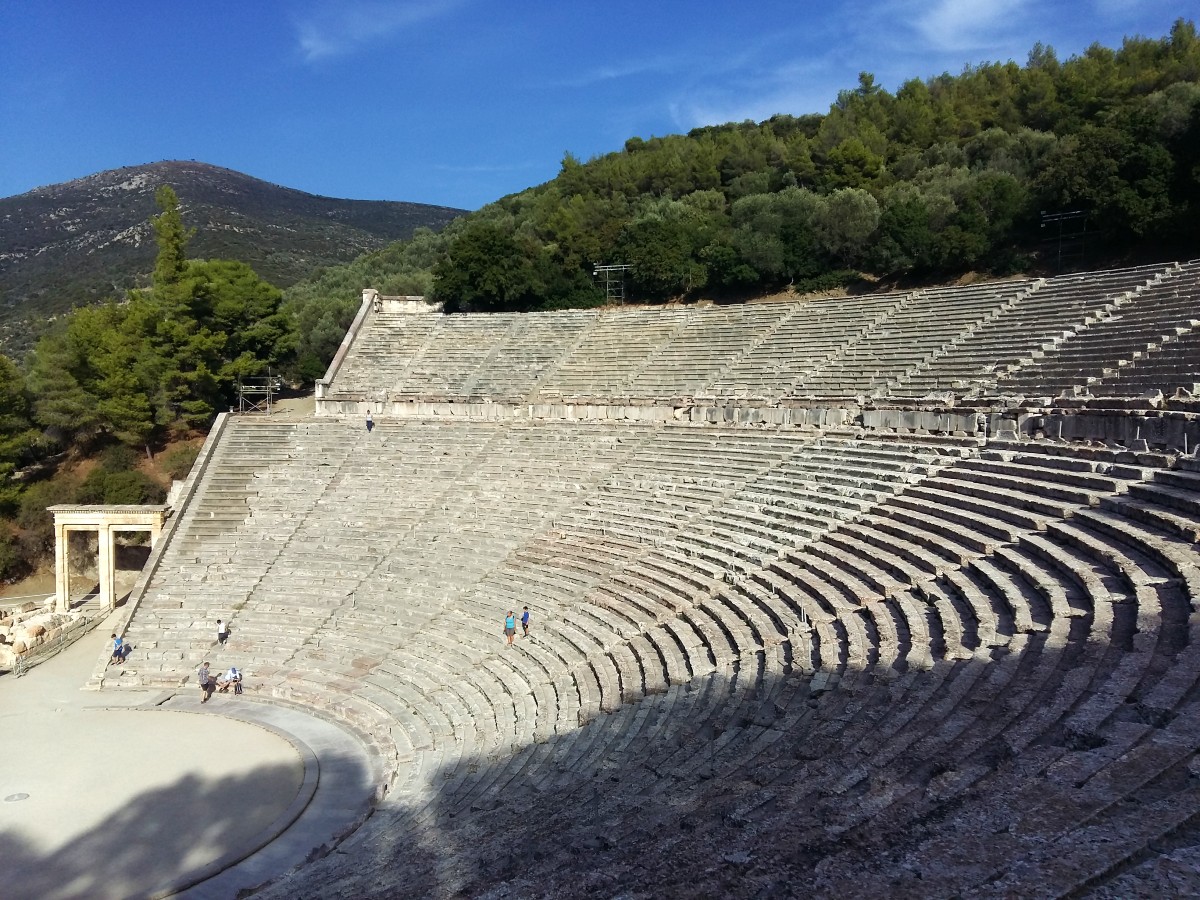
The theatre’s design was unique throughout Greece, and aimed to enhance the viewing experience. Its incredible acoustics and crystal-clear sound amaze visitors to this day and age.
As for its location on the slope of Mt Kynortion, the word “stunning” is really an understatement.
The theatre is surrounded by the typical Peloponnesian landscape, and the area is surprisingly calm and quiet, especially if you visit off-season.
Other monuments inside the Asklepieion
Many visitors are overwhelmed by the theatre, and tend to quickly run through the rest of the archaeological complex.
If you are planning to visit, make sure you set some time aside to explore the whole area properly. You will definitely be impressed by how advanced the Ancient Greeks were.
Alongside the theatre and the temple of Asklepios, the complex included a stadium, where athletic games were held to honour the god. Seats made out of clay, stones and limestone have been discovered.
Apart from sporting competitions, other events were held in the stadium. Just like the ancient Great Panathenaia in Athens, the Great Asklepieia included athletic competitions, music, ancient drama and rhapsody contests.
The Epidaurus ancient treatment centre
To facilitate the treatment and accommodation of patients and their escorts, a number of other buildings were constructed in the area.
The Tholos, also known as Thymele, was a perfectly designed circular building, crucial to the cult of Asklepios. The construction hosted the god’s underground residence, where he was believed to heal the diseased.

Marble, poros and wood were used for its construction, and it was lavishly decorated with sculptures and paintings.
Another important building was the Stoa of the Abaton, also known as the Enkoimeterion, where patients were brought for therapy. After being purified with holy water, they were led to an area where they would be able to sleep.
Asklepios would visit them in their dreams, often providing a remedy for their ailments. When a solution wasn’t possible through dreaming, patients had to further consult the priests of Asklepios.
Accommodation in Ancient Epidaurus
The biggest construction in the grounds of the sanctuary was a large guesthouse with 160 rooms, known as the Katagogio.
This is where all visitors and their escorts were hosted. It was built around the end of the 4th century BC and was reconstructed during the Roman Era.
Another building found nearby was a banqueting hall, where ceremonial meals were served in the presence of Asklepios. During the Roman Era, an odeon was constructed to be used for performances.

Several other buildings, sanctuaries and statues existed in the area. Apart from Apollo’s temple, there was also one dedicated to the goddess Artemis. There were the magnificent Propylaia, the baths, the priest’s residences etc.
In line with other ancient complexes, Ancient Epidaurus was abandoned after 426 AD, when Theodosius II banned the non-Christian cults. It was rediscovered and first excavated towards the late 18th century.
The museum in Ancient Epidaurus
If you have been to other museums in Athens or Greece, you may find the museum of Ancient Epidaurus a little old-fashioned. You are right, as the museum was built in the beginning of the 20th century.
It seems that no particular effort has been made to bring it up to modern standards. This doesn’t mean, however, that the museum is uninteresting – quite the contrary.
The exhibits in the museum range from the Archaic period to the Roman era. Visitors can see various ancient medicinal tools such as scalpels, proving the advanced medical knowledge of the Ancient Greeks. There are also statues, sculptures, figurines and ruins of several buildings.
What I found extremely interesting were the ancient inscriptions, indicating the healing powers of Asklepios. Additionally, you can learn more about therapeutical practices, remedies and popular diets of the time.

For example, to eliminate digestive issues, a diet of cheese, bread, milk, honey and celery was recommended, alongside moderate exercise. Who would have thought!
Performances at the Ancient theatre of Epidaurus
Excavation works at the archaeological site began in 1881. Extensive restoration works were performed, and the theatre is almost fully recovered.
The Ancient theatre at Epidaurus has been hosting various open-air performances since 1954. Hundreds of famous Greek and international actors have appeared here over the years.
The performances are held during Greece’s biggest cultural festival, the Athens and Epidaurus Festival.
The site comes alive on summer weekends, when thousands of people arrive to witness an unforgettable experience. If your dates allow it, you should absolutely aim to see a performance here.
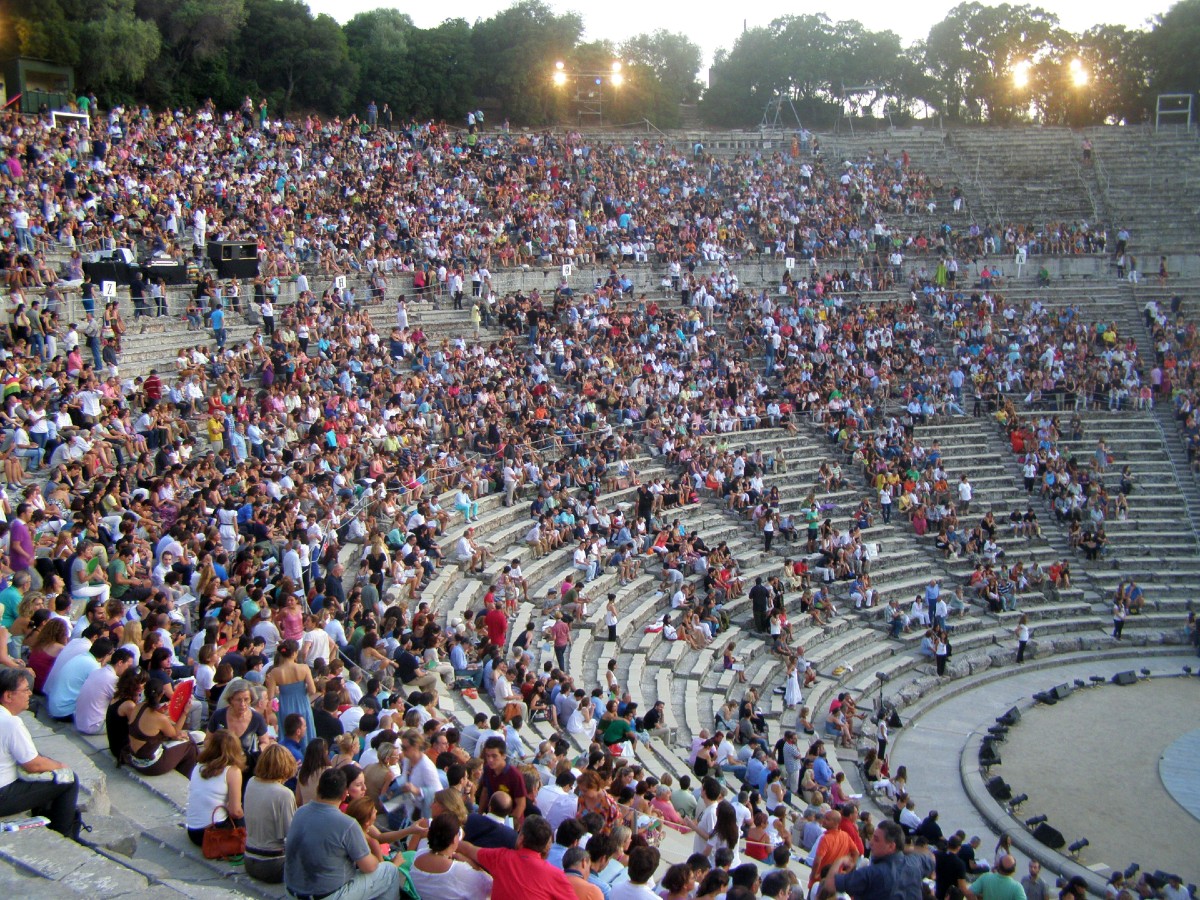
Even if you are not sure about a specific play, just go and experience the Ancient Theatre of Epidaurus at night. Performances usually come with English surtitles.
Note that there are also performances in the nearby Little Theatre of Ancient Epidaurus. This is a completely different theatre, located to the south-east of Palaia Epidavros.
Check out the Greek Festival’s official website for more information.
Where is the theatre of Ancient Epidaurus
If you type in “Epidaurus” in Google Maps, you will be directed to a larger area in the Peloponnese. You will need to type in “Epidaurus theatre” instead.
Alternatively, you can type in “Epidavros”, which is the Greek word for Epidaurus. This will point you to the whole ancient complex.

As you will notice, all monuments in the archaeological complex are clearly marked. For example, you can see the “temple of Asklepios at Epidaurus” and the “Stadium of the Asclepieion of Epidaurus”.
Further to the east of the ancient site, you will see two towns called “Nea Epidavros” and “Palaia Epidavros”. The latter is a small coastal settlement, ideal for those who want to spend a few days in the area.
How to get from Athens to the theatre of Ancient Epidaurus
There are three ways to get to Ancient Epidaurus: by car, public bus, or organized tour.
By car: If you are happy to drive around Greece, you can rent a car. The region of Epidaurus is 160 kms away from Athens, and you can comfortably drive there in about two hours.
By bus: Depending on the season, there are one or two Athens Epidaurus buses per day. There are also some connections with other places in the Peloponnese. Unfortunately, the timings of the buses and round trip options can be rather inconvenient. You can check itineraries and book your tickets at the official KTEL Argolida bus website.
By organized tour: This is the easiest option, especially if you are interested in visiting more attractions in the area. Here are a few popular day-trips from Athens:
- Ancient Epidaurus, Ancient Mycenae and the town of Nafplio
- Ancient Mycenae and Ancient Epidaurus
- Nafplio and Ancient Epidaurus
- Private tour to Epidaurus, Mycenae and Nafplio
If you are going to a performance and don’t have your own transport, you can check the Athens Epidaurus public buses or this link. You will need to have your performance ticket handy, as you will need to use the barcode number to book your bus ticket.
Opening hours for the site and Epidaurus festival
The site closes at 20.00 in summer, and at 17.00 in winter (November – March). If you are visiting during the shoulder season, check out the exact closing time on the official website.
Summer performances at the theatre typically start at 21.00. Make sure you are there well in advance, to find your seat.
Accommodation in Epidaurus
If you are visiting the area for several days, there are many towns and areas you can stay. The most popular option is Nafplion, the pretty coastal town. Moreover, Palaia Epidavros and Tolo are both lovely to spend a night or a few days.
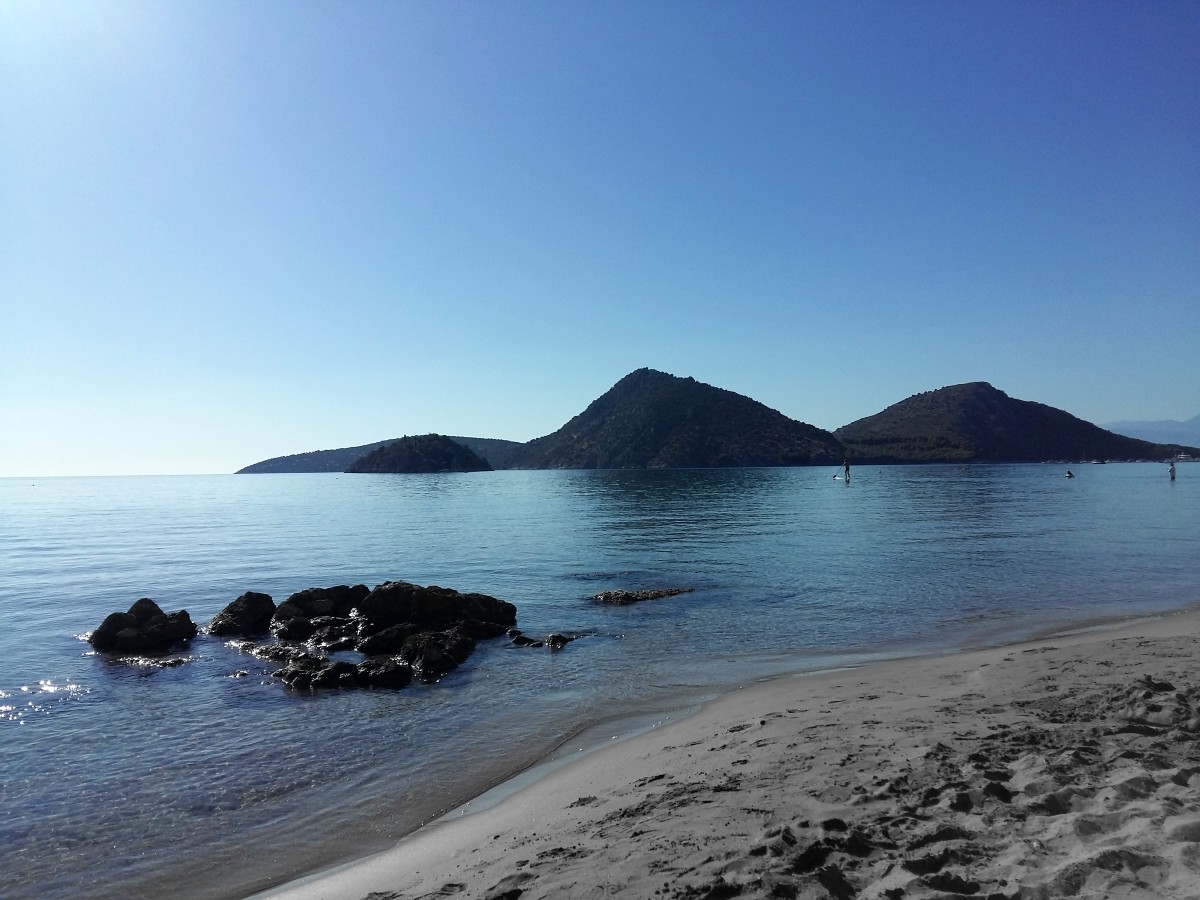
As you would expect, all these areas tend to get busy in summer. Plan your accommodation well in advance, especially if you are visiting on a weekend.
FAQs about the Ancient theatre of Epidaurus
People often ask the following questions:
What is Epidaurus famous for?
Epidaurus is known for its magnificent ancient theatre with the excellent acoustics. The theatre is located inside the sanctuary of Asklepios, the god of medicine and healing.
Why was the theater of Epidaurus important?
Epidaurus was home to the most famous therapeutic / wellness centre of antiquity. The theater hosted theatrical performances, which, according to ancient Greeks, could help improve the physical and psychological health of patients.
Where do you find Epidaurus theatre?
The theatre is located in the area of Epidaurus in the Peloponnese, a two-hour drive from Athens and 30 minutes from Nafplio.
What is the theatre of Epidaurus used for today?
Today, the theatre of Epidaurus can be visited year round. In addition, it is used for various performances during the summer.
Why would Greek actors wear masks on stage?
There were several reasons why masks were used on stage. They enabled actors to play several roles, each of which was shaped by the dramatic expression on the mask. Moreover, they made it easier for far-away spectators to identify each character.
Have you been to the Ancient Theatre in Epidaurus?
Have you been to this impressive site? Were you aware of Asklepios and his cult? Let me know in the comments!
Since you are here, you will probably enjoy these other articles
- Ancient theatres in Greece
- Best Greek mythology movies
- The twelve Olympian Gods and their love stories
- Athens day trips
- Best tours in the Peloponnese
- Ten beautiful coastal towns in mainland Greece
Also, have a look at this article on Euphoria Retreat near Mystras, a unique spa resort that follows the principles of Hippocratic medicine!

Hi! I am Vanessa from Athens, and I love helping visitors find out more about Greece. I was absolutely fascinated with the story behind Ancient Epidaurus and the Asklepieion, and I hope you will be too! Follow my FB page and FB group for more stories about Greece.

Muy impresionante e interesante, majestuoso y muchas sensaciones indescriptibles que se sienten a pesar de solo ver las fotografías.
Los amo
Gracias!!!